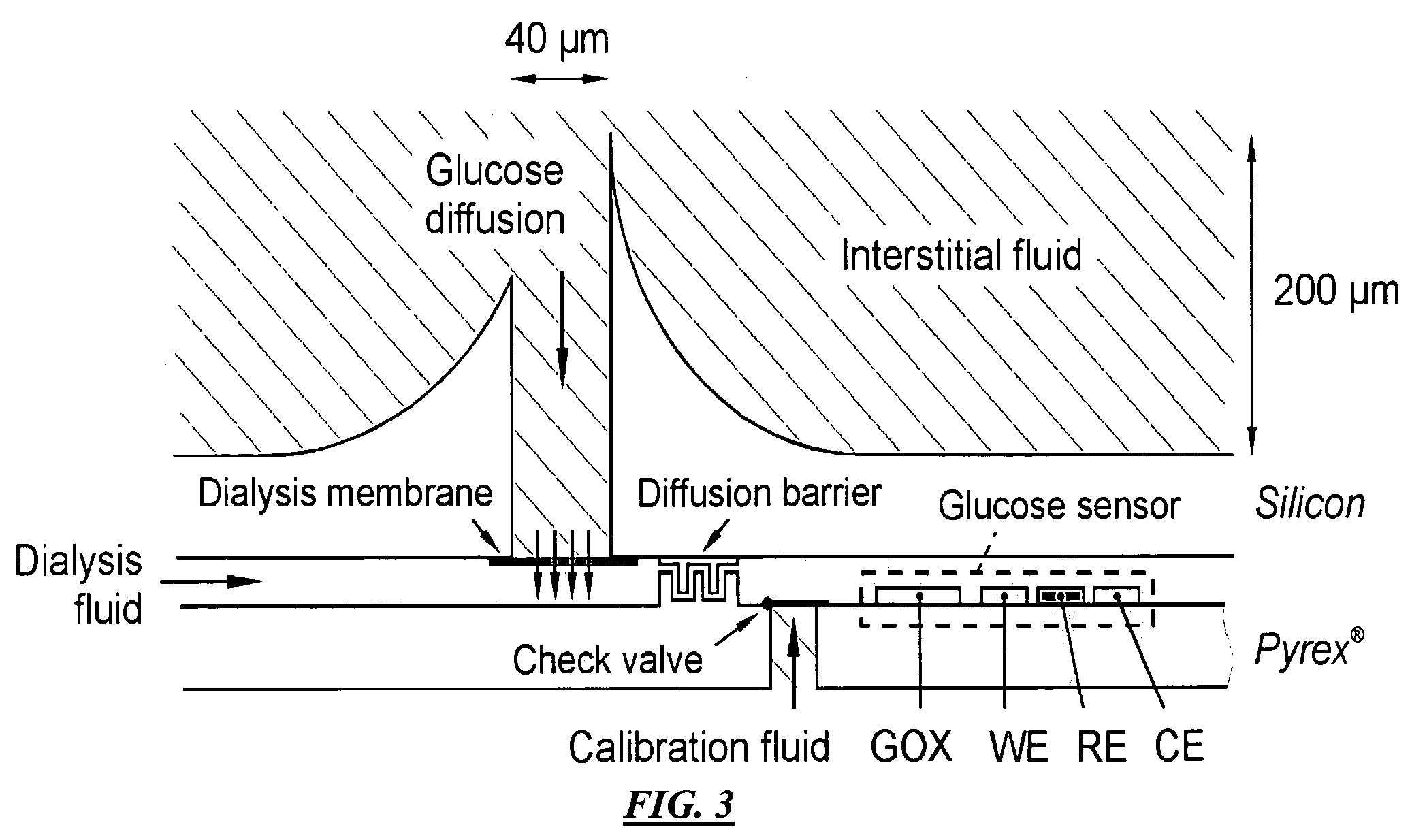Monitoring method and/or apparatus
a monitoring method and/or a technology of a monitoring device, applied in the field of monitoring methods and/or apparatus, can solve the problems of affecting the accuracy of sensor readings, and affecting the accuracy of measurement results, etc., to achieve the effect of facilitating sensor recalibration, reducing the risk of recurrence, and minimally invasiv
- Summary
- Abstract
- Description
- Claims
- Application Information
AI Technical Summary
Benefits of technology
Problems solved by technology
Method used
Image
Examples
example 1
[0058]FIG. 1 is a schematic diagram of an example microneedle-based continuous monitor wherein microneedle lumens are filled with interstitial fluid by capillary action and a substance of interest diffuses through the integrated dialysis membrane into dialysis fluid that is pumped past an integrated enzyme-based flow-through sensor according to specific embodiments of the invention. In this example, an array of hollow out-of-plane microneedles is used to penetrate the skin and to interface with the interstitial fluid. A dialysis membrane separates the interstitial fluid and the dialysis fluid; thus, no interstitial fluid is extracted during operation. Dialysis fluid with a known constant glucose concentration is continuously pumped past the dialysis membrane and an integrated sensor (e.g., for glucose). Glucose diffuses through the microneedles and through the dialysis membrane into or out of the dialysis fluid. The concentration change in dialysis fluid is measured—it depends on th...
example 2
[0059]FIG. 3 is a schematic diagram of an example microneedle-based continuous monitor including a separate calibration fluid system according to specific embodiments of the invention. In this further specific example, operation of the example sensor can be understood as follows. An group of, for example, about 200 μm long hollow out-of-plane microneedles are used to penetrate the topmost layer of the skin, allowing their opening to come in contact with interstitial fluid from the epidermis. Once the microneedles are either filled with interstitial fluid or once sufficient time has elapsed for a substance of interest to diffuse into prefilled needles, the substance of interest (e.g., glucose) diffuses through the dialysis membrane into dialysis fluid, keeping unwanted substances (e.g., larger protein molecules) outside of the dialysis area, thus improving the sensor long-term stability.
[0060]Various detection strategies can be used for detecting substances of interest. Different str...
example 3
[0067]FIG. 4 illustrates an example schematic diagram of a sensor system showing three representative microneedles, a dialysis membrane, fluid reservoirs and pumps, according to specific embodiments of the present invention. In this example system, separate calibration and dialysis fluids reservoirs are used, with two micropumps and valves as shown.
PUM
 Login to View More
Login to View More Abstract
Description
Claims
Application Information
 Login to View More
Login to View More - R&D
- Intellectual Property
- Life Sciences
- Materials
- Tech Scout
- Unparalleled Data Quality
- Higher Quality Content
- 60% Fewer Hallucinations
Browse by: Latest US Patents, China's latest patents, Technical Efficacy Thesaurus, Application Domain, Technology Topic, Popular Technical Reports.
© 2025 PatSnap. All rights reserved.Legal|Privacy policy|Modern Slavery Act Transparency Statement|Sitemap|About US| Contact US: help@patsnap.com



